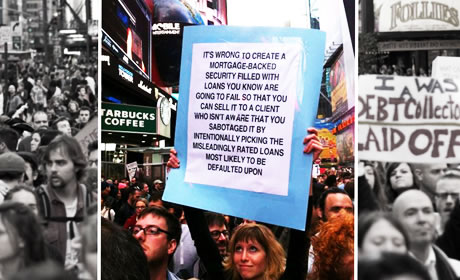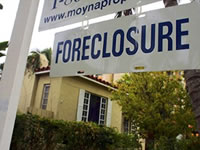Fannie Mae and Freddie Mac
Refinance
Avowed 1%er Schiff gives mortgage-backed securities a pass

by Broderick Perkins
(11/7/2011) - When Peter Schiff recently chastised Wall Street Occupiers for pointing the finger at the financial industry's role in the broken economy, he ironically blamed unresponsive federal regulators for plunging the economy into recession.
Schiff, a self-proclaimed 1%er and CEO of Euro Pacific Capital, Inc. frequently admonishes regulators for not taking a back seat to the free market.
"Big government has wrecked the us economy not capitalism," Schiff told CNN's Anderson Cooper, after his visit with occupiers at New York's Zuccotti Park.
"If the government wasn't guaranteeing bank accounts banks would be a lot more responsible," said Schiff, on one hand complaining the government didn't do its job, on the other saying it should back off it's regulatory role.
Whether Schiff, also a talk show host, was just grandstanding or tripping over his own thoughts isn't clear.
One thing is clear. He can't have it both ways.
Numerous studies do indeed reveal regulators didn't act with their vested powers when they should have, but it's what they didn't act upon that helped plunge the nation into the Great Recession.
Most notably, toxic mortgage-backed securities and other mortgage related investments were allowed to run amok, according to a host of studies.
Financial Crisis Inquiry Report
The corrosion of mortgage-lending standards and the pipeline that transported toxic mortgages throughout the nation contributed heavily to the Great Recession, according to the Financial Crisis Inquiry Commission's (FCIC) "Financial Crisis Inquiry Report."
The report said lenders knowingly tossed aside ethics and responsibility to steer consumers to mortgages they couldn't afford and then repackaged those risky loans as securities sold to investors, including the federal government, without disclosing the risk.
Later, when home prices crashed and millions of home owners defaulted on unaffordable home loans, the securities likewise bombed, sparking a flame that swept through the economy.
The events helped usher in the worst recession since the Great Depression.
Congress created the commission in 2009 to examine the causes behind the economic meltdown that lingers today.
"Lenders made loans that they knew borrowers could not afford and (loans) that could cause massive losses to investors in mortgage securities," according to the report.
In a partial nod to one side of Schiff's mouth, the most damning news from the report is that the ensuing economic calamity was avoidable.
"The captains of finance and the public stewards of our financial system ignored warnings and failed to question, understand, and manage evolving risks within a system essential to the well-being of the American public. Theirs was a big miss, not a stumble," the FCIC report says.
In its conclusions the FCIC report said: "We conclude, collapsing mortgage-lending standards and the mortgage securitization pipeline lit and spread the flame of contagion and crisis."
Wall Street's role
Despite Schiff's diatribes, another study puts much of the blame for the mortgage meltdown squarely at the feet of Wall Street, rather than federal government sponsored enterprises (GSEs) Fannie Mae and Freddie Mac.
Research from the Center for Responsible Lending (CRL) "Wall Street, Not Fannie Mae & Freddie Mac, Created & Led the Toxic Mortgage Market," says toxic subprime loans started the foreclosure crisis and the disaster spread to other mortgages approved without properly qualifying borrowers.
"The facts show that Fannie Mae and Freddie Mac were followers, not leaders, in the events leading up to today's foreclosure epidemic," the report says.
"During the 2000s, subprime mortgage lending grew rapidly as Wall Street seized on the opportunity to invest in riskier, higher-interest mortgages. 'Securitization' ... made it possible for loosely-regulated lenders to make loans and then immediately sell them to private firms that created mortgage-backed securities."
CRL's report says:
• GSEs were prohibited from buying subprime mortgages because the loans were outside the prescribed GSE guidelines. Subprime mortgage-backed securities were created in the private sector by Wall Street firms.
• GSEs did purchase subprime mortgage-backed securities as investments, but not in a volume that matched Wall Street purchases.
• GSEs eventually guaranteed and created investments with "Alt-A" loans which went to relatively wealthier borrowers with higher credit scores. The loans did have risky features, such as limited documentation. These investments are primarily why the GSEs were placed into conservatorship. GSEs investments were generally less risky than Wall Street's, but the private market and the GSEs share responsibility for supporting the loans.
• Mortgage loans purchased by Fannie Mae and Freddie Mac - including loans to lower-income borrowers - were performing better than those on the private market. Last year, 13.35 percent of GSE loans to borrowers with credit scores under 660 were 90 or more days delinquent or in foreclosure, compared to 28 percent for subprime loans, according to Mortgage Bankers Association statistics.
Refinance at Today's Low Rates!
Follow the link to continue reading this article.
Paying credit cards on time, letting the mortgage go, common among struggling households
Underwater homeowner bailout considered with bank settlement
Banks' big bailout payback after regulators rollover on terms
CFPB to release new mortgage rules next year
Lawmakers push for more urgency from FHFA
Fannie Mae & Jumbo Mortgage Rates
Just One Click! = Current Rate Chart


